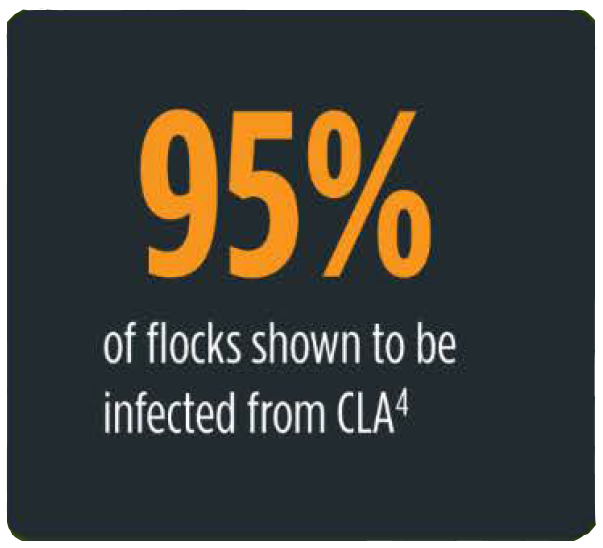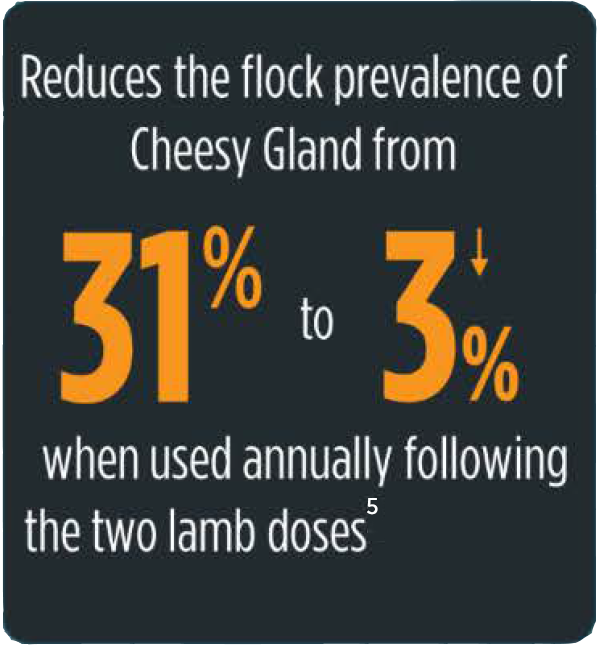GLANVAC
The Glanvac range protects your flocks’ productivity and wool clip against Cheesy Gland (CLA) and Clostridial diseases.
There is a range of Glanvac products to meet your needs as an Australian sheep producer. All of these products protect against Cheesy Gland. Cheesy Gland is one of the most common and costly bacterial diseases seen on sheep farms in Australia.
Cheesy Gland impacts:
- Wool production
- Ram fertility
- Carcass quality through contamination
- Increased carcass trimming
- Farm productivity
Controlling Cheesy Gland is difficult, as it is largely a hidden disease with few clinical signs, but the initial infection may cause fever and loss of appetite. Internal organ abscesses can result in ill-thrift and the incidence of Cheesy Gland increases as the sheep become older. the impact of this disease on their flock can be minimised.
Cheesy Gland is seen as abscesses under the skin of infected sheep (in the lymph nodes), but these abscesses can also appear in the lungs and other internal organs. The abscesses initially contain soft, pasty pus which hardens over time to form a firm, dry substance.
The main source of infection are those animals with lung abscesses that ‘cough’ infective material onto other animals when in close contact, e.g. yarding post-shearing, feedlots or sheep camps. Sheep with lung abscesses can cough up the bacteria, exposing other animals to the bacteria as it enters through their skin. Aerosol transmission is more likely to occur when sheep are yarded together.
 Another potential source of infection is material from ruptured superficial abscesses that contaminate pastures, handling equipment, shearing equipment and dipping fluid. Ruptured abscesses contain large numbers of infective bacteria, which can survive for months in the environment. The bacteria are highly contagious. The bacteria can survive in the environment for a long period of time – up to 8 months in soil, 4 months in shearing sheds and 24 hours in sheep dips.
Another potential source of infection is material from ruptured superficial abscesses that contaminate pastures, handling equipment, shearing equipment and dipping fluid. Ruptured abscesses contain large numbers of infective bacteria, which can survive for months in the environment. The bacteria are highly contagious. The bacteria can survive in the environment for a long period of time – up to 8 months in soil, 4 months in shearing sheds and 24 hours in sheep dips.
The Glanvac range prevents CLA through a complete vaccination program of 2 doses in unvaccinated sheep and lambs with an annual booster dose within 4-12 weeks of shearing, generally at pre-lambing for ewes.
The Glanvac 3 range also protect against the clostridial disease of Tetanus and Pulpy Kidney, with the Glanvac 6 adding protection against Blackleg, Black disease and Malignant Oedema. With both the Glanvac 3 and Glanvac 6 vaccine range, Selenium and or Vitamin B12 can be included to the single dose. Selenium deficiency causes while white muscle disease killing lambs and subclinical low fertility in ewes and rams. Vitamin B12 is vital for energy production which is vital for body and wool growth. Deficiencies in Vitamin B12 causes loss of appetite, decreased growth rates, reduction in wool quality and quantity
The Glanvac range is registered for use in the Glanvac+Eryvac Dual Vaccinator with Eryvac to protect your flock from these disease with Selenium and Vitamin B12 supplementation in a single dose.
For further information please click here and visit Livestock Solutions on the Zoetis website.
References
1. Cost Benefit Analysis of Eryvac in Commercial Sheep Flocks, prepared by SBScibus. Zoetis data on file, 2013
2. Farquharson, B. (2007). Arthritis in prime sheep lambs, A review. MLA Final Report AWH.123, North Sydney
3. Meat & Livestock Australia Limited National Trade Lamb Indicator at $5.75 per kg ctw, May 2015
4. Paton MW, et al. Prevalence of Caseous lymphadenitis and usage of Caseous lymphadenitis vaccine in sheep flocks. AVJ 2003; 81(1&2): 91–95.
5. National Sheep Health Monitoring Project (2013). Animal Health Australia. Zoetis data on file.